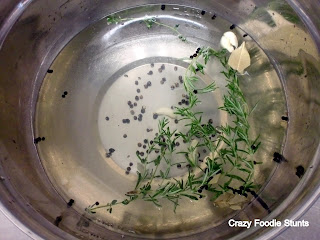
Readers of my old website might remember seeing this recipe about a year ago. It begs the obvious question why publish it again, dummy? Well, when I first prepared this dish, I remember the rice was flavorful, but the chicken was bland. After preparing this dish a few more times, I eventually fixed it by using a brine.
What exactly is a brine? A brine is basically a salt water solution along with other seasonings to add moisture and flavor, resulting in juicier food. Marinades are similar to brines but work to tenderize and add flavor to proteins using an acidic ingredient such as vinegars or citrus juices.
The Challenge
Fix an inferior concept while elevating a dish and demonstrating a technique to improve flavor.
The Source
The brine is original but the dish has been adapted from page 345 of America's Test Kitchen Family Cookbook Third Edition.
Ingredients
2 quarts water
1/2 cup kosher salt
1/2 cup white sugar
1/2 teaspoon black peppercorns, cracked
1 bay leaf
Juice from 1/2 lemon
2 cloves garlic, crushed
1 sprig rosemary
1 sprig thyme
kosher salt and freshly ground black pepper
1 tablespoon vegetable oil
1 onion, chopped medium
1/4 teaspoon red pepper flakes
4 cloves garlic, minced
1 1/2 cups long grain white rice
3 1/2 cups low sodium chicken broth
1/2 cup dry white wine
lemon wedges (for serving)
*Items italicized can be changed depending on availability, and preference.
Method
1. Whisk 1/2 cup kosher salt and 1/2 cup white sugar into 2 quarts water until dissolved. Stir in the (other seasonings) and submerge the chicken completely in the brine and refrigerate for 2 to 4 hours in a resealable bag, turning halfway through.
2. Remove the chicken from the brine and discard the brine. Pat the chicken dry with paper towels and season with kosher salt and freshly ground black pepper. Heat oil in a large Dutch oven over medium high heat until just smoking. Add the chicken, skin side down and cook until golden, about 5 minutes. Transfer the chicken to a plate, leaving the fat in the pot.
3. Add the onion, red pepper flakes, and 1/2 teaspoon kosher salt to the fat in the pot and place over medium heat. Cook, scraping up any fond (browned bits) until the onion is softened, about 5 minutes.
4. Stir in the garlic and cook until fragrant, about 15 seconds. Stir in the rice and cook until the edges turn translucent, about 3 minutes. Stir in the broth and the wine and bring to a simmer.
5. Return the chicken to the pot, skin side up. Cover, reduce heat to low and cook until the chicken is fully cooked through and registers 175 Fahrenheit on an instant read thermometer, about 25 minutes.
6. Transfer the chicken to a serving platter.
Successful?
Yes, both the rice and the chicken were flavorful.






















